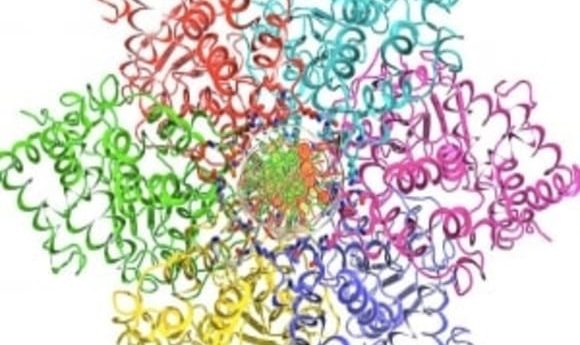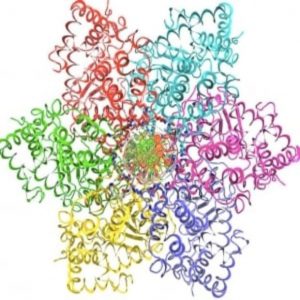Putting the squeeze on DNA

Exactly how does the DNA replication process start? USC scientists provide the first snapshot of how double-helix DNA begins to unwind and replicate after certain proteins put on the “squeeze.”

A ring of six proteins known as a helicase surrounds the DNA strands at a special location known as origin DNA. Each of the six proteins is in distinct color, with origin DNA in the center.
Credit: Xiaojiang Chen, USC
DNA replication begins with the initial opening up of an intertwined DNA double helix, enabling the vital information stored inside to be copied. However, exactly how the DNA “opening” phase is initiated has remained a mystery.
Now for the first time, researchers show that DNA replication in mammalian cells initiates after a vise-like ring of special proteins assemble, surround, and bind to the double-stranded DNA structure. The study, published in eLife, details how these protein rings, called helicases, “squeeze” the strands to open up the DNA, kicking off the replication process.
“You would think that in order to open something, it would need to be pulled apart, or something would need to be inserted between to pry and open,” explained Xiaojiang Chen, who led the study at the University of Southern California. “But surprisingly, nature has found another way.”
Chen’s lab began to study the mechanism behind DNA opening in eukaryotic cells by observing the same process in simian virus 40 (SV40) s. The team discovered that the virus hijacks normal DNA replication by mirroring the protein helicase mechanism used for DNA opening in healthy eukaryotic cells.
Using X-ray crystallography, Chen’s lab showed how six separate subunits of proteins of the virus’s helicase each make unique bonds with the DNA at the replication origin site. After squeezing and melting this site to separate the two DNA strands, the virus then starts copying its own DNA.
Chen says the SV40 model may help researchers learn to prevent viruses from hijacking the DNA replication process. To get there, many other steps of DNA replication still need to be understood, such as how the melted DNA origin is opened up even more fully to produce the Y-shaped DNA replication fork.
“The DNA replication process is very complicated, and this is probably only a small step, which has opened up more questions than we’ve answered,” said Chen. “However, as we add to knowledge from this finding, we might someday be able to design something to intervene at this critical step to block cancer cell replication or viral replication and infection in the future.”